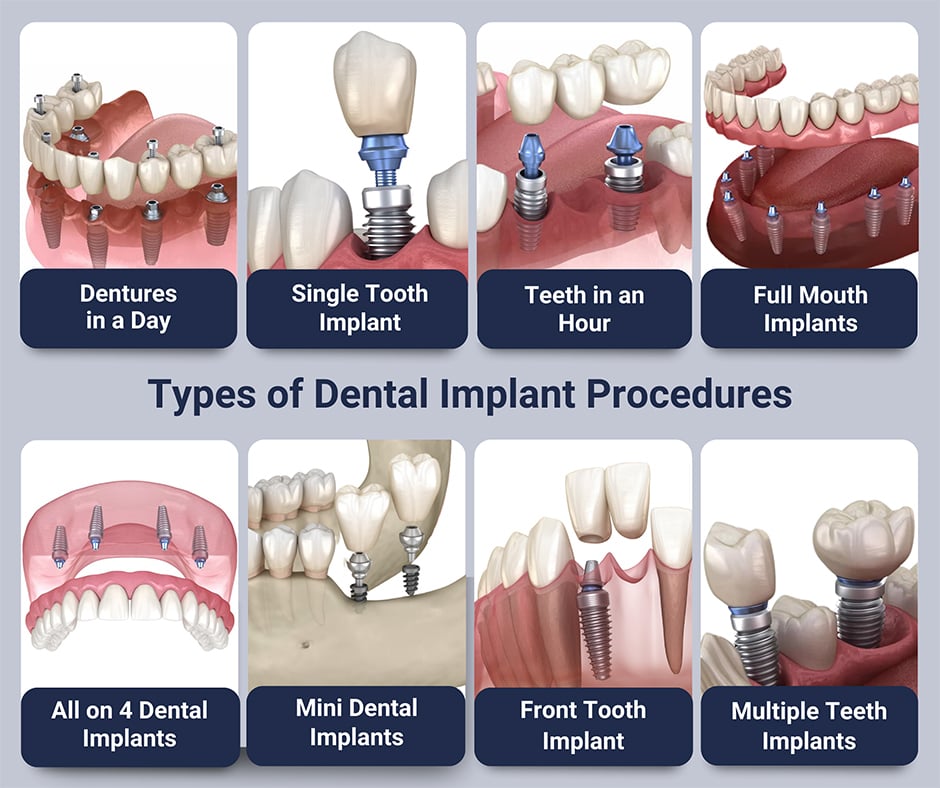Examine This Report about Dental Implants
Examine This Report about Dental Implants
Blog Article
Getting The Dental Implants To Work
Table of ContentsAn Unbiased View of Dental ImplantsAll about Dental ImplantsThe Best Strategy To Use For Dental ImplantsA Biased View of Dental Implants
are medical gadgets surgically dental implanted into the jaw to restore a person's capability to chew or their appearance. They offer assistance for fabricated (fake) teeth, such as crowns, bridges, or dentures. When a tooth is shed because of injury or disease, an individual can experience complications such as fast bone loss, malfunctioning speech, or changes to chewing patterns that result in pain.
Framework of The Oral Implant System picking oral implants, speak with your oral copyright regarding the prospective advantages and risks, and whether you are a candidate for the treatment. Things to think about: Your total wellness is a crucial consider figuring out whether you are a great candidate for dental implants, exactly how long it will certainly require to heal, and for how long the implant may remain in area.
Smoking may influence the recovery procedure and lower the long-lasting success of the implant. The recovery procedure for the implant body may take numerous months or longer, throughout which time you typically have a short-term abutment in location of the tooth. the dental implant procedure: Thoroughly follow the oral health instructions offered to you by your dental copyright.
A Biased View of Dental Implants
Implant failure can result in the demand for an additional operation to take care of or change the implant system. Recovers the capacity to eat Brings back aesthetic appearance Aids keep the jawbone from diminishing due to bone loss Protects the wellness of the surrounding bone and gum tissues Helps keep surrounding (close-by) teeth steady Enhances top quality of life Damages to bordering natural teeth throughout implant positioning Injury to the surrounding tissues during surgical procedure, such as sinus perforation Injury throughout surgical procedure (for instance, crack of bordering jawbone) Inadequate function, such as seeming like the teeth do not attack with each other normally A sensation that the tooth is loose or twisting in position resulting from a joint screw loosening up Implant body failing (looseness of the dental implant body) due to systemic infection, which may be most likely in patients with uncontrolled diabetes due to neighborhood infection in bone and gum tissues supporting the dental implant body due to delayed healing, which might be a lot more most likely in individuals who smoke Trouble cleansing the gum tissues around the dental implant, leading to poor dental health Without treatment gum important site condition Post-surgical pins and needles due to nerve impingement or damages Always notify healthcare suppliers and imaging technicians that you have dental implants before any kind of magnetic resonance imaging (MRI) or x-ray procedures.
FDA is not aware of any damaging events reported for MRI or x-ray treatments with oral implants. Oral implants systems are generally constructed from materials that adhere to worldwide agreement requirements of the International Company for Standardization (ISO) or ASTM International. These criteria have details of what makes a safe product.
Other materials such as gold alloys, cobalt-based alloys, titanium alloys, or ceramic materials are often used. The safety profiles of these products are widely known. Dental dental implant systems are examined according to international consensus criteria. Biocompatibility testing, to show that bodily contact with the tool does not create problems like inflammation or allergic reaction, is component of the examination that aids guarantee the materials in the oral implant system are safe and do not trigger adverse results when dental implanted in people.

Rumored Buzz on Dental Implants
Some people are not eligible for dental implant surgical treatment. It is for oral surgeons to operate individuals with: intense illnessuncontrollable metabolic diseasebone or soft tissue condition or infectionIf these problems are dealt with, an individual can have the surgical read here procedure. Dental Implants. In, dental specialists avoid operating individuals with: If individuals with any one of the above undertake dental implant surgical treatment, there is a greater threat of the implant failing
Some individuals have a jawbone irregularity that stops sufficient bone for a dental implant from creating. The specialist will certainly then make use of a bone or bone replacement to repair and build up the area.
Oral dental implant surgical procedure is a personalized procedure. It's not the exact same for everybody. The complying with provides a general overview of what you can anticipate your dental professional, oral cosmetic surgeon, periodontist or prosthodontist to do: Place the dental implant surgically. Offer you time to recover. Attach the blog post and final crown, bridge or denture.
Next, your surgeon will carefully put the dental implant into your jaw. Your cosmetic surgeon will certainly rearrange your gum tissues and close the cut with stitches site link (Dental Implants). If your implant is near the front of your mouth, your dentist will certainly make a temporary tooth for you to put on till you heal. By doing this, you won't have a gap in your smile while you recoup.
Dental Implants - Truths
Your company can tell you what to expect in your circumstance. Throughout the recovery stage, your jawbone needs to fuse to the oral implant. This procedure, called osseointegration, is vital for stability and long-lasting success. This process can take anywhere from three to 9 months. In many cases, it may take much longer.
As soon as your dental implant heals, your dental professional can affix the joint (little connector post) and your last reconstruction (crown, bridge or denture). This usually takes regarding one hour to complete and might need a 2nd small surgical procedure. You should not feel any discomfort throughout your oral implant procedure because your service provider will utilize medicine to numb your gums.
Report this page